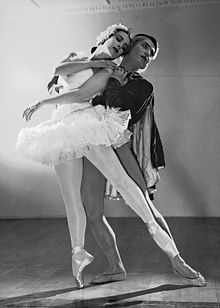Jean Rosenthal
Jean Rosenthal (born Eugenia Rosenthal March 16, 1912 - May 1, 1969) is considered a pioneer in the field of theatrical lighting design. She was born in New York City to Romanian-Jewish immigrants.[1][2]
In the early part of the 20th century, the lighting designer was not a formalized position. Rather the set designer or electrician handled the lighting of a production. Rosenthal helped make the lighting designer an integral member of the design team.[1] She also said that lighting "was a career in itself".[3] As well as particular lighting innovations, she created an atmosphere specific to the production, and she was in demand as a Broadway lighting designer.[4]
In 1929, she was introduced to Martha Graham at the Neighborhood Playhouse School of the Theatre. She became Graham's technical assistant, which led to a lifelong collaboration with Graham. She worked with Graham on 36 productions.[5] Rosenthal studied lighting design at the Yale School of Drama from 1931 to 1934 with Stanley McCandless.[2]
She returned to New York City, where she joined the Federal Theatre Project in 1935. This led to collaborations with Orson Welles and John Houseman. She would later follow Welles to the Mercury Theatre,[2] where she was credited as a member of the board in addition to production and lighting manager, although not as lighting designer.
Some of her major contributions were the elimination of shadows by using floods of upstage lighting and controlling angles and mass of illumination to create contrasts without shadows.[6] "Some of the signature lighting she did for Balanchine and the diagonal shaft of light she created for Graham (lovingly referred to by her as "Martha's Finger of God"), are now in such widespread use by dance companies of every style that they have become standards of the lighting repertoire."[7]
She was light designer for hundreds of productions, including Broadway, Martha Graham's dances, the New York City Ballet, and the Metropolitan Opera. On Broadway she lit musicals such as West Side Story (1957), The Sound of Music (1959), Take Me Along (1959), A Funny Thing Happened on the Way to the Forum (1962), Fiddler on the Roof (1964), Hello, Dolly! (1964), Cabaret (1966), and The Happy Time (1968).
Death
On May 1, 1969, she died of cancer at the age of 57. Her book, Magic of Light: The Craft and Career of Jean Rosenthal, Pioneer in Lighting for the Modern Stage, (Little Brown & Co, ISBN 0-316-93120-9) was published posthumously in 1972. Lael Wertenbaker assembled the book, a long-running project between her and Rosenthal, from tape-recorded dictation sessions.[8]
References
- ↑ 1.0 1.1 Jean Rosenthal biography at the Wayback Machine (archived August 24, 2002) northern.edu, retrieved May 20, 2009
- ↑ 2.0 2.1 2.2 Fippin, Carol.BiographyJewish Women's Archive, 2005, accessed May 24, 2009
- ↑ Dunning, Jennifer."Lighting The Way Into A Sense Of Space",The New York Times, October 27, 1996
- ↑ Boone, Mary Callahan, "Jean Rosenthal's Light: Making Visible the Magician",Theatre Topics, March 1997, pp. 77-92
- ↑ Freedman, Russell., Martha Graham, a dancer's life (1998), Houghton Mifflin Harcourt, ISBN 0-395-74655-8, p. 106
- ↑ Jean Rosenthal Dies Here at 57, The New York Times May 2, 1969, p. 43
- ↑ West, Martha.The light fantastic,Dance Magazine, February 1996
- ↑ listing amazon.com
External links
- Internet Broadway Database listing, retrieved May 20, 2009
- Jean Rosenthal, 1912-1969 by Larry Wild, Northern State University
- The Lighting Archive, online examples of Jean Rosenthal light plots, hookups, shop orders, cue sheets and focus charts
| ||||||||||||||||||||||||||||||||||||
|
